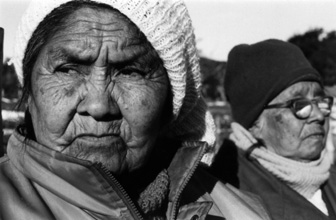La última huella
Die letzte Spur
The Last Trace
Paola Castillo
Chile 2001 |
| |
|
 |
|
|
Arsenal 1
09.02., 17.30
CineStar 8
10.02., 17.00
|
|
|
|
|
Produktion: Ceneca Producción, Errante
Producción
Weltvertrieb: Ceneca Producción
Padre Mariano 72, Providencia,
Santiago de Chile
Tel.: (56-2) 35 06 27
eMail: ceneca@entelchile.net
Buch: Paola Castillo, Tiziana Panizza
Kamera: Eduardo Cruz Coke
Ton: Alvaro Silva
Schnitt: Coti Donoso
Musik: Sergio ‚Tilo’ González
Ausführender Produzent: Adrián Solar
Allgemeine Produktion: Ricardo Cantuarias
Format: Beta-SP Pal, Farbe und s/w
Länge: 63 Minuten
Sprache: yagan und spanisch |
|
|
|
|
Im südlichsten Zipfel Amerikas, in einer der unwirtlichsten
Klimazonen lebte das Volk der Yaganes. Bis auf zwei direkte
Nachfahren von hohem Alter, Úrsula und Cristina Calderón,
ist
es ausgestorben. Mit den beiden Frauen drohten auch ihre Kultur
und ihre Sprache zu verschwinden. Deshalb werden inzwischen
intensive Versuche unternommen, um die ‘letzten Spuren’ der
Yaganes für die Nachwelt festzuhalten. Patricia Castillo hat das
Leben der beiden Alten und ihre Geschichte dokumentiert und
der Kultur von einem der letzten indianischen Völker Chiles poetischen
Ausdruck verliehen.
Paola Castillo: „Dokumentarfilm ist Erinnerung. Die beiden Frauen
sprechen ständig von der Vergangenheit, die sie noch erlebt haben.
Es ist eine fortwährende Sehnsucht, in diese Zeit zurückzukehren
und den Moment einzufangen, in dem sie sich mit der
Landschaft, ihrer Welt und ihren Traditionen verbunden fühlten,
in diesen Raum, in dem sie sich trotz aller Schwierigkeiten glücklich
fühlten. Es ist auch das Protokoll eines Augenblicks, der letzten
Stimmen, die als Vermächtnis bleiben... Man kann die Welt
der Yaganes nicht ohne ihre Landschaft verstehen. Ihre Religiosität,
ihre sozialen Bindungen, ihr Wesen, all dies wurzelt in der
Geografie, in der sie leben. Der Wind, das Wasser, der Gebirgszug,
der im Meer versinkt, die Kälte: Sie sind Teil ihres steten Kampfs
gegen die Natur, aber auch ihrer Symbiose mit ihr.“
|
| |
|
|
The Yagan people once inhabited one of
the world’s most inhospitable regions on
the southernmost tip of America. Today,
their numbers have dwindled to just two
direct descendents, Úrsula and Cristina
Calderon. When these very old women die
they will in all likelihood take their culture
and language to the grave with them. For
this reason, much effort is being spent
recording the last remaining traces of the
Yaganes for posterity. Paola Castillo went
in search of these traces, documented the
lives of the two old women and described
in poetic manner the culture of one of
Chile’s last indigenous peoples.
Paola Castillo: “The documentary is a memory.
The two women constantly speak
about a past which they still experienced.
They constantly long to return to that time
and try to capture the moment when they
were at one with nature, their world and
their traditions; a world in which they were
happy in spite of all the difficulties. It is
also a snapshot of a moment, of the last
voices that will be their legacy. You can’t
understand the world of the Yaganes without
reference to their surroundings. Their
religious beliefs, their social relationships,
indeed their very nature are a function of
their geographic location. The wind, the
water, the mountain range that sinks into
the ocean, the cold – all this is part of their
constant battle against nature, but also
their symbiotic relationship with it.“
|
| |
|
Biographien / Biographies
Paola Castillo Villagrán, geb. 1969 in Santiago de Chile. Filmstudium
in Cuba und Spanien. Filme seit 1992: Piscis (Kurzspielfilm, 1994), Buscando
al Chino (Kurzspielfilm, 1998), Niños del paraíso (Dokumentarfilm,
zusammen mit Valeria Vargas, 2000). La última huella ist ihr erster
langer Film. |
